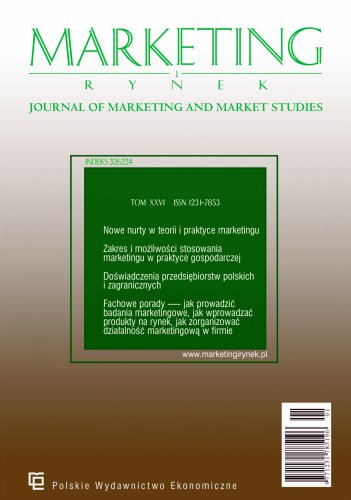Chinese bronze crafts market
The aim of the article is to introduce the subject of the Chinese bronze market which could fill an information gap, which is extremely important from the craft marketing point of view. To achieve this goal, the method of analyzing the existing data was used – literature and Chinese journalists' articles. The article presents, among others, the demand and supply side of this market, the importance of artisanal bronze products in the economic culture of China, the specificity of this craft, and the division of the market into the ancient and modern. One of main conclusions is the observation that contemporary Chinese bronze craftsmanship is not a topic chosen for research and publication within the disciplines of Economics and Finance Sciences, and Management and Quality Sciences. Therefore, characterizing the contemporary Chinese bronze market based only on literature is not fully possible with the current availability of information. The text also points out that the group of craftsmen working with bronze in China is diversified, and the survival and profitability of this craft may largely depend on how it is popularized and promoted.
References
Bibliografia/References
A bronze relief craftsman in Qingdao. 08.11.2017. http://www.china.org.cn/travel/qingdao/2017-11/08/content_41863373.htm
Archeologia Wschodu. (2012). Krótko o starożytnych chińskich naczyniach brązowych. https://archeologiawschodu.wordpress.com/2012/01/22/krotkoo-starozytnych-chinskich-naczyniach-brazowych/
Bai, Y. X. (2003). A discussion on early metals and the origins of bronze casting in China. Chinese Archaeology, 3, 157–165. https://doi.org/10.1515/CHAR.2003.3.1.157
Bavarian, B. & Reiner, L. (2006). Piece mold, lost wax & composite casting techniques of the Chinese Bronze Age. http://www.csun.edu/~bavarian/Badynasty/Chinese_Bronze_Casting%202006.pdf
Bishop, C. W. (2023). Two Chinese bronze vessels. The Museum Journal, IX(2). https://www.penn.museum/sites/journal/641/
Campbell, R. B. (2014). Archaeology of the Chinese Bronze Age: From Erlitou to Anyang, The Cotsen Institute of Archaeology Press. https://doi.org/10.2307/j.ctvdjrr9r.12
Chase, W. T. (1994). Chinese bronzes: Casting, finishing, patination, and corrosion. W: D. A. Scott, J. Podany, & B. B. Considine, Ancient & Historic Metals: Conservation and Scientific Research (85–117). The Getty Conservation Institute.
Chinese master "Five Bulls and Five Fortunes" on the Spring Festival Gala, this is the most beautiful cow in 2021. https://inf.news/en/culture/84e228834b4c3b02a81e15faeadca37e.html (dostęp 29.05.2022).
Czerska, I. & Michalczyk, R. (2017). Marketing nostalgiczny jako szansa dla renesansu rzemiosła na Dolnym Śląsku. Prace Naukowe Uniwersytetu Ekonomicznego we Wrocławiu, (490, Gospodarka miejska przyszłości. Perspektywa województwa dolnośląskiego), 113–120. https://doi.org/10.15611/pn.2017.490.10
Deydier, C. (2015). Understanding Ancient Chinese Bronzes, Their Importance in Chinese Culture, Their Shapes, Functions and Motifs. Galerie Christian Deydier.
Discover China: Ancient bronze craft embraces golden age thanks to thriving Tibetans. 05.09.2020. http://www.xinhuanet.com/english/2020-09/05/c_139345063.htm
Encyklopedia PWN. (b.d.). Chińskie brązy. https://encyklopedia.pwn.pl/haslo/chinskie-brazy;3885306.html (dostęp: 21.12.2022).
Guss, A. (2020). Środki ochrony niematerialnego dziedzictwa kultury w Chińskiej Republice Ludowej. Gdańskie Studia Azji Wschodniej, (17), 200–217. https://doi.org/10.4467/23538724gs.20.027.12145
Huang, B. (2022). The posture of Lalitasana: Buddhist posing hierarchy in a Tang-Dynasty Chinese bronze sculpture. Religions, 13(8), 740. https://doi.org/10.3390/rel13080740
Jaffe, Y., Hein, A., Womack, A., Brunson, K., d'Alpoim Guedes, J., Guo, R. Z., Zhou, J., Ko, J., Wu, X. H., Wang, H., Li, S. C. & Flad, R. (2021). Complex pathways towards emergent pastoral settlements: New research on the Bronze Age Xindian Culture of northwest China, Journal of World Prehistory, 34, 595–647. https://doi.org/10.1007/s10963-021-09160-w
Kajdański, E. (2005). Chiny. Leksykon. Książka i Wiedza.
Kirino, F., Ohono, N. & Taguchi, S. (2019). Metal craft production techniques for an ancient Chinese coin named Ittou manufactured in the Shin period of ancient China. Journal of the Japan Institute of Metals and Materials, 83(3), 87–96. https://doi.org/10.2320/jinstmet.j2018045
Künstler, M. J. (1991). Sztuka Chin. Wiedza Powszechna.
Künstler, M. J. (2007). Dzieje kultury chińskiej. Wydawnictwo Naukowe PWN.
Lopes, R. O. (2015). Securing the harmony between the High and the Low: Power animals and symbols of political authority in ancient Chinese jades and bronzes. Asian Perspectives, 53(2), 195–225. https://doi.org/10.1353/asi.2014.0019
Mei, J. J., Yu, Y. B., Chen, K. L. & Wang, L. (2017). The appropriation of early bronze technology in China. W: P. W. Stockhammer, & J. Maran, (Red.) Appropriating Innovations Entangled Knowledge in Eurasia. 5000–1500 BCE (231–240). Oxbow. https://doi.org/10.2307/j.ctt1vgw6v1.21
Photographing China: Qinghai craftsman's life in bronze. 22.12.2021. http://www.news.cn/english/2021-12/22/c_1310387759.htm
Prodan, M. (1975). Sztuka chińska. Państwowe Wydawnictwo Naukowe.
Reiner, L. (2007). Ancient Chinese Bronze Casting. Advanced Materials & Processes.
Rudnik, S. (1998). Metaloznawstwo. Wydawnictwo Naukowe PWN.
Rządowy Program Polski Inkubator Rzemiosła. (2021). https://niw.gov.pl/wp-content/uploads/2021/07/Program-PIR-1.pdf
Scarpari, M. (2008). Starożytne Chiny. Skarby sztuki. Ediciones Folio.
Słownik języka polskiego PWN (b.d.). Brązownictwo. https://sjp.pwn.pl/szukaj/br%C4%85zownictwo.html (dostęp: 03.12.2022).
Spotted bronze glimmers in Yunnan province. 06.09.2016. http://www.chinadaily.com.cn/culture/2016-09/06/content_26713756.htm
Tan, W. Y. (2020). Bronze burners as superb as the incense they emit. 04.03.2020. https://www.shine.cn/feature/art-culture/2003043525/
Tang, J. G. (2020). China: Bronzes from around the world reunite in a digital museum. The UNESCO Courier, UNESCO. https://doi.org/10.18356/c59deb04-en
The Britannica Dictionary (b.d.). Chinese bronzes. https://www.britannica.com/art/Chinese-bronzes (dostęp: 21.12.2022).
Treister, M., & Ravich, I. (2021). Chinese mirrors from the burials of the nomads of Eastern Europe of the second half of the 1st millennium BC-first centuries AD: Typology, chronology, distribution and technology of manufacture. Advances in Archaeomaterials, 2(1), 24–48. https://doi.org/10.1016/j.aia.2021.07.001
UN. (2015). Transforming Our World: The 2030 Agenda for Sustainable Development. A/RES/70/1. World Health Organization.
Wang, X. T., Luo, W. G., Yang, Y. D., Chen, D., Du, J., & Tang X. (2020). Preliminary discussion on the highly radiogenic lead in unalloyed copper artifacts of the Eastern Zhou dynasty: Starting from the Huili copper spearheads. Metals, 10(9), 1252. https://doi.org/10.3390/met10091252
Wang, Y., Qin, Z., Hou, W. & Storozum, M. (2022). Water conservancy system and urban layout of Yinxu, the capital city of Shang: A GIS approach. Land, 11(7), 986. https://doi.org/10.3390/land11070986
Wen, R. J. (2008). Kaogongji yizhu. Shangahi guji, 41–43.
Wielkopolska Izba Rzemieślnicza w Poznaniu. (b.d.). Marketing internetowy nową siłą rzemiosła. https://www.irpoznan.com.pl/strona,marketinginternetowy-nowa-sila-rzemiosla.html (dostęp: 21.12.2022).
Works of art from the young craftsmen joint exhibition. https://www.findsuzhou.com/exhibition/works-of-art-from-the-young-craftsmen-joint-suzhouart-exhibition/ (dostęp: 29.05.2022).
Xu, Y. Y. (2013). The knowledge system of the traditional Chinese craftsman. West 86th, 20(2), 155-172. https://doi.org/10.1086/674727
Zeng, W. H. (2012). A bronze birthright. http://www.bjreview.com/special/2012-09/05/content_489325.htm
大写湖北人|国家级非遗大师敖朝宗,他让沉睡千年的青铜器“起死回生. 23.11.2019. https://www.sohu.com/a/355502335_120207620
飞刀走线 刻镂成模(工匠绝活). 11.07.2017. http://news.66wz.com/system/2017/07/11/105008270.shtml
国家非遗之景泰蓝,国大师操刀设计,宫苑琳琅,匠意天成. https://posts.careerengine.us/p/61f8376896b9c73b8487e27a?from=latest-posts-panel&type=previewimage (dostęp: 01.02.2022).
上海民众走近“让文物活起来”的工匠 体验文物修复. http://www.xinhuanet.com/photo/2018-01/17/c_1122269347_10.htm (dostęp: 29.01.2022).
璜土这对父子工匠,破解青铜镜的透光之谜 . https://www.ysstreet.com/plugin.php?id=tom_tctoutiao&site=100009&mod=info&aid=147 (dostęp: 29.01.2022).
刘瑞朝, 亮相春晚的青铜大面具 河南文物修复师曾参与修复工作. 01.02.2022. https://www.henan100.com/news/2022/1071996.shtml
苏州工匠传承“失蜡法” 用心铸就行走的“青铜时代”. 09.05.2020. https://www.jntimes.cn/jnwm/202005/t20200509_6636146.shtml
王永战, 工匠绝活|修旧如旧 重现神韵. 06.08.2021. http://yn.yunnan.cn/system/2021/08/06/031598294.shtml
中国古代青铜冶铸技术 (b.d.). https://baike.baidu.com/item/%E4%B8%AD%E5%9B%BD%E5%8F%A4%E4%BB%A3%E9%9D%92%E9%93%9C%E5%86%B6%E9%93%B8%E6%8A%80%E6%9C%AF/2542441 (dostęp: 01.02.2022).

